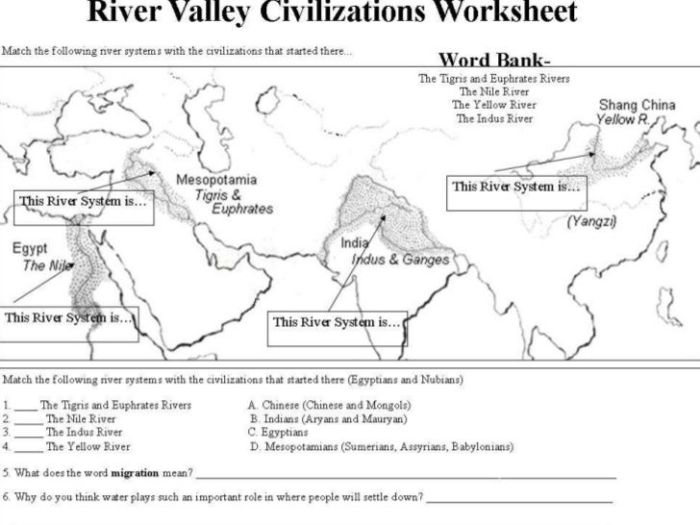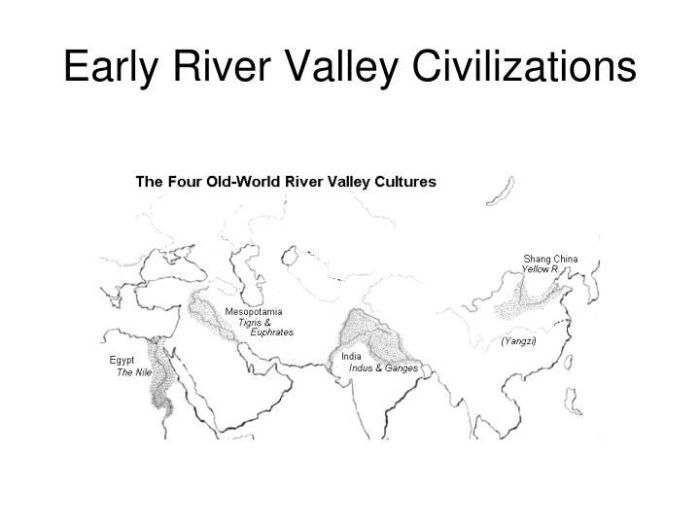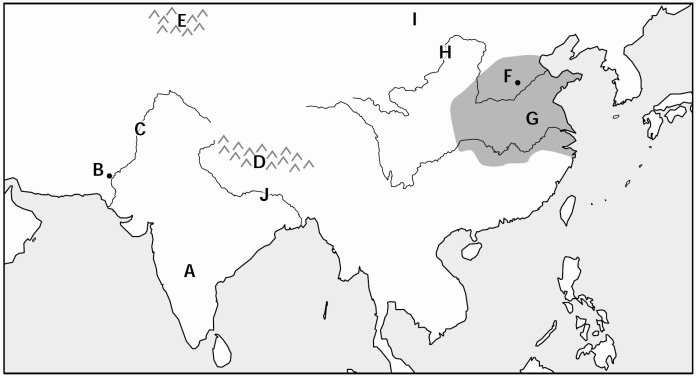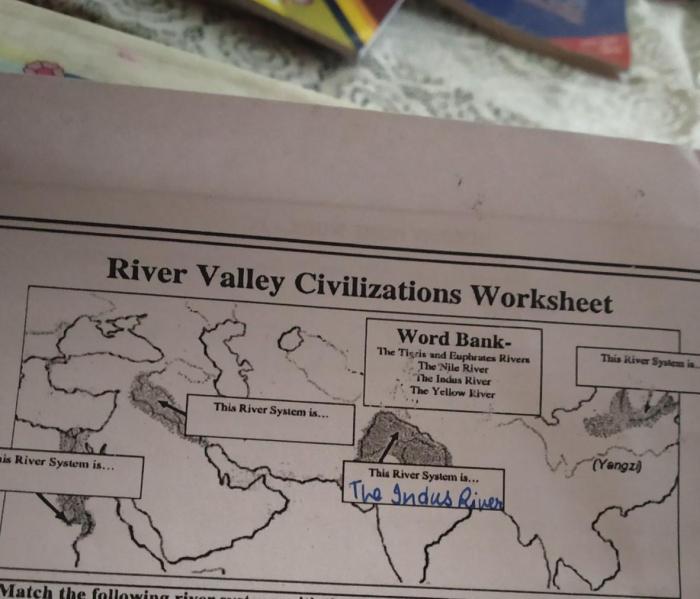Embark on an illuminating journey through the enigmatic realm of river valley civilizations worksheet answer key, where the seeds of human civilization were sown. From the fertile banks of Mesopotamia to the majestic Nile Delta, this comprehensive guide unravels the intricate tapestry of ancient societies, their remarkable achievements, and their enduring impact on the world we inhabit today.
Within these pages, you will discover the geographical and environmental factors that fostered the rise of these vibrant civilizations. Explore the complex social hierarchies and political systems that governed their societies, and delve into the economic activities that sustained their growth.
Witness the birth of writing, mathematics, astronomy, and art, and unravel the profound influence of religious beliefs and practices on their daily lives.
1. Civilizations of the River Valleys

The major river valley civilizations include Mesopotamia, Egypt, Indus Valley, and Huang He. These civilizations flourished in fertile river valleys and developed complex societies, writing systems, and technological advancements.
Geographical Features and Environmental Factors, River valley civilizations worksheet answer key
- Mesopotamia:Located between the Tigris and Euphrates rivers, with a warm, dry climate suitable for agriculture.
- Egypt:Situated along the Nile River, with a predictable flooding pattern that enriched the soil and supported farming.
- Indus Valley:Located in the Indus River valley, with a monsoon climate that provided ample rainfall for agriculture.
- Huang He:Situated along the Yellow River, with a fertile loess soil that was ideal for farming and millet cultivation.
2. Social and Political Structures: River Valley Civilizations Worksheet Answer Key

River valley civilizations had complex social hierarchies and political systems.
Social Hierarchies
- Rulers:Kings or emperors who held supreme power.
- Priests:Religious leaders who played a significant role in political and economic affairs.
- Scribes:Literate individuals who recorded laws, administrative documents, and religious texts.
- Commoners:The majority of the population, including farmers, artisans, and laborers.
Political Systems
- Mesopotamia:City-states with a strong central government and a complex bureaucracy.
- Egypt:A centralized monarchy with a powerful pharaoh and a well-organized administration.
- Indus Valley:A decentralized civilization with a network of independent cities.
- Huang He:A hierarchical society with a centralized government and a feudal system.
3. Economic Activities

River valley civilizations relied on agriculture, trade, and crafts for economic sustenance.
Agriculture
- Irrigation systems:Developed to expand agricultural production and increase crop yields.
- Crops:Wheat, barley, rice, millet, and vegetables were the main crops cultivated.
- Livestock:Cattle, sheep, goats, and pigs were raised for food and other resources.
Trade
- Long-distance trade:River networks and overland routes facilitated trade between different regions.
- Goods traded:Included agricultural products, luxury goods, and raw materials.
Crafts
- Pottery:Produced for storage, cooking, and decorative purposes.
- Metalworking:Copper, bronze, and iron were used to create tools, weapons, and jewelry.
- Textiles:Woven from wool, linen, and cotton for clothing and other purposes.
4. Cultural and Intellectual Achievements

River valley civilizations made significant contributions to the development of human knowledge and culture.
Writing Systems
- Mesopotamia:Cuneiform, a wedge-shaped script used for writing on clay tablets.
- Egypt:Hieroglyphics, a system of writing using pictorial symbols.
- Indus Valley:Indus script, an undeciphered script.
- Huang He:Chinese characters, a logographic script used to write the Chinese language.
Mathematics and Astronomy
- Mathematics:Developed systems of measurement, arithmetic, and geometry.
- Astronomy:Observed the stars and planets, creating calendars and predicting celestial events.
Art and Architecture
- Mesopotamia:Ziggurats, monumental temple towers.
- Egypt:Pyramids, tombs for pharaohs, and temples.
- Indus Valley:Planned cities with grid-like streets and advanced sanitation systems.
- Huang He:Bronzeware with intricate designs and ceremonial significance.
Popular Questions
What are the key features of river valley civilizations?
River valley civilizations were characterized by their reliance on major rivers for water, transportation, and agriculture, leading to the development of complex social structures, centralized governments, and advancements in technology and culture.
How did geographical factors contribute to the development of river valley civilizations?
Geographical factors such as fertile soil, access to water, and natural barriers provided favorable conditions for the growth of agriculture and the establishment of permanent settlements, which laid the foundation for the emergence of complex societies.
What were the major economic activities of river valley civilizations?
Agriculture was the primary economic activity, supplemented by trade, crafts, and the development of specialized industries such as metalworking and pottery.
What were the significant cultural and intellectual achievements of river valley civilizations?
These civilizations made remarkable advancements in writing, mathematics, astronomy, and art, leaving behind a rich legacy of knowledge and cultural heritage that continues to influence modern society.